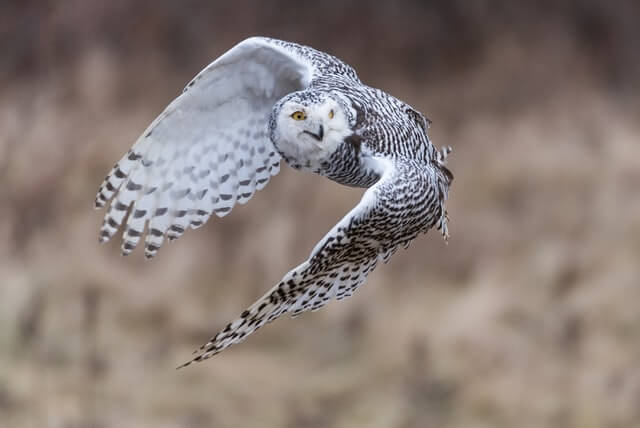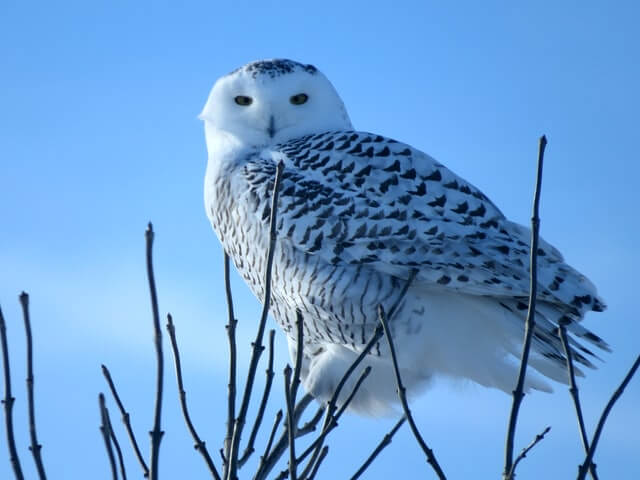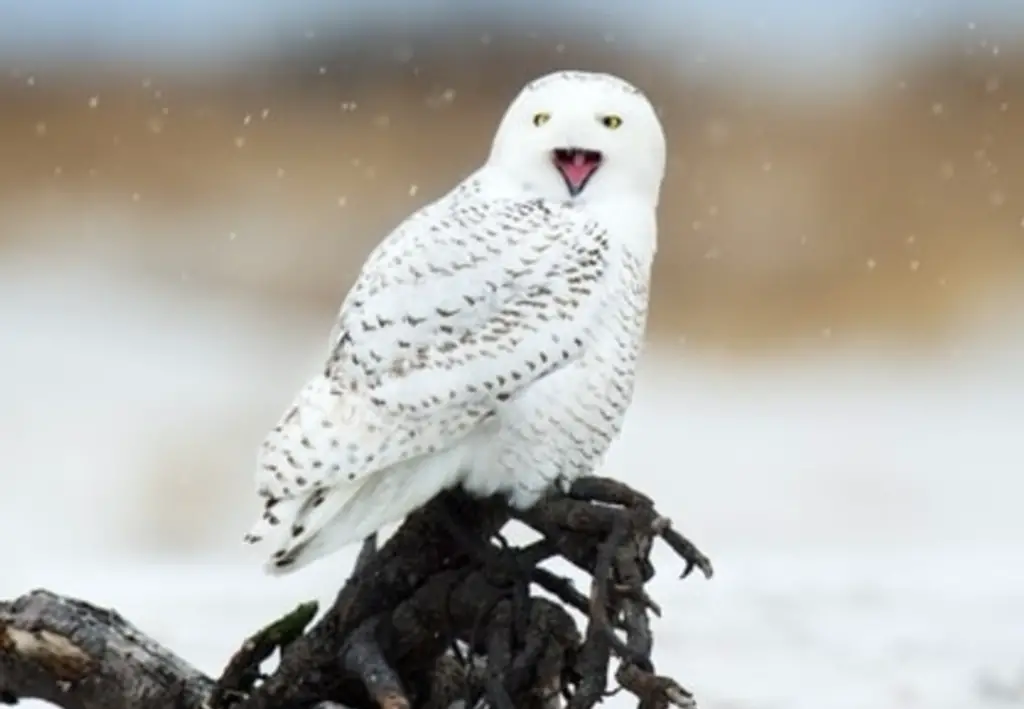If you’re looking to learn everything there is to know about snowy owls, you’ve come to the right place. This full guide will provide you with 48 fun facts about snowy owls, as well as photos and identification tips.
You’ll also find information on their appearance, behavior, habitat, range maps, calls, songs and more. So what are you waiting for? Let’s get started!
Table of Contents
- 1 Overview
- 2 Fun Facts About Snowy Owls
- 2.1 Snowy Owls can fly at speeds up to 80 km/h (50 mph).
- 2.2 They have a heart rate of 200 bpm when resting.
- 2.3 They are the 2nd largest owl in North America.
- 2.4 Snowy Owls find refuge in Canada’s Arctic regions.
- 2.5 Snowy Owls swallow their prey whole.
- 2.6 They build their nests on the ground.
- 2.7 Snowy Owls can detect prey through the pads of their feet.
- 2.8 The Snowy Owl has insulating feathers.
- 2.9 They have the potential to live up to 30 years.
- 2.10 The Snowy Owl is a diurnal raptor.
- 2.11 Snowy owls nest on the ground.
- 2.12 A baby Snowy Owl is called an “Owlet.”
- 2.13 They can see 3x better than humans.
- 2.14 Snowy Owls will “Hiss” or “Bark” if threatened.
- 2.15 They will “Hoot” or “Coo” when courting and mating.
- 2.16 Snowy owls are monogamous and mate for life.
- 2.17 They can rotate their heads 270 degrees.
- 2.18 Snowy Owls are the heaviest species of owl in North America.
- 2.19 Females are 20% larger than males.
- 2.20 Snowy Owls are the official bird of Quebec.
- 2.21 Snowy Owls will eat 4-7 lemmings each day.
- 2.22 The Snowy Owl is a bird of many names.
- 2.23 Snowy Owls need a pound of food every day to survive
- 2.24 This bird eats flesh, and then regurgitates bones.
- 2.25 Baby Owlets are born blind and without feathers.
- 2.26 Their skeleton makes up about 7-9% of its total body weight.
- 2.27 Snowy Owls use sound waves to hunt for prey.
- 3 Frequently Asked Questions
- 4 Author
Overview
- Identification: The adult male’s plumage is snow-white, and can be identified by its three black bars on the tail feathers. The females are also white with black spots and barring throughout the body and wings. The Snowy Owl’s legs are covered in feathers up to the toes, but the talons themselves are black. The eyes have yellow irises with black pupils, and the beak is short with a downward hook, for tearing into flesh.
- Length: 20.5-28.0 in (52-71.1 cm)
- Weight: 56.5-104.1 oz (3.5-6.5 lbs.)
- Wingspan: 49.2-57.1 in (125-145 cm)
- Order: Strigiformes
- Family: Strigidae
- Genus: Bubo
- Scientific Name: Bubo scandiacus
- Range: Its range extends from the Arctic tundra to the northern regions of North America, Europe, Asia and Russia.
- Migration: Some small populations may migrate to southern states such as Texas, Georgia or Florida.
- Habitat: Arctic tundra, boreal forests, prairies, mountainsides and even agricultural fields.
- Diet: Mainly eat small mammals such as lemmings, voles, hares, shrews, ground squirrels and carrion, but they will occasionally hunt for other prey such as ducks or geese.
- Global Population: est. 100,000 individuals.
- Breeding Pairs Population: est. 28,000 pairs.
- Conservation Status: Listed Least Concern (Population is decreasing)
- Nesting Habits: It is common for these birds to nest on ground level, often in open fields where they can easily see predators coming from a distance. They will typically build their nests near some type of vegetation which provides protection against wind and precipitation while allowing for warmth during colder months. These birds prefer nesting near water, as well.
- Incubation Length: 32 days
- Nestling Length: 18-25 days
- Clutch Size: 3-11 eggs
- Number of Broods: 1 Brood
Fun Facts About Snowy Owls
Snowy Owls can fly at speeds up to 80 km/h (50 mph).
Snowy Owls are one of the most widespread owl species in North America. They can fly at speeds up to 80 km/h (50 mph) and hunt in open areas like tundra, grasslands, wetlands, and farm fields.

They have a heart rate of 200 bpm when resting.
Snowy Owls have a heart rate of 200 beats per minute when resting. This is because of energy metabolism and thermoregulation. Snowy owls live in the Arctic, so they need to be able to keep their body temperature up as well as expend a lot of energy looking for food during the winter months. When they hunt, their heart rates go up and can reach 288-300 beats per minute!
They are the 2nd largest owl in North America.
Snowy owls are the second-largest owl in North America. They can grow up to 28 inches tall and have a wingspan of almost 5 feet. These birds weigh between 3 and 6.5pounds, with females being slightly larger than males.
Snowy Owls find refuge in Canada’s Arctic regions.
Snowy owls generally migrate south in winter but some live year-round in Canada’s Arctic regions, like Ontario’s Wapusk National Park, which has an estimated population of up to 150 individuals.
Canada has taken steps to protect these creatures by creating a system of protected areas across its Northern Territory and instituting strict laws against hunting them. In the summer months, these birds have been spotted as far south as Texas and California.
Snowy Owls swallow their prey whole.
The Snowy Owls stomach can stretch up to three times its original size, allowing them to swallow animals one-third their own size! Snowy owls swallow their prey whole and have stomachs that can expand to allow for large meals. The stomach is divided into two sections: the gizzard and the proventriculus.
It is only when the food passes through these organs that it becomes compacted into small pellets called boluses. Snowy owls then pass these boluses as part of what they excrete, or as part of what they defecate.
They build their nests on the ground.
These birds nest on the ground, and they use an abandoned burrow, natural depression, or excavation site to lay their eggs. The males will do most of the hunting, while females stay at home and care for the young owls.
Snowy Owls can detect prey through the pads of their feet.
Snowy Owls also have the ability to feel the vibrations of their prey through the pads of their feet. This helps them detect potential food sources even when they can’t see them or hear them coming, so they are never without sustenance in any season.
The pads of their feet are covered with thousands of nerve endings that help them feel prey on the ground below. This allows them to hunt without making a sound.
The Snowy Owl has insulating feathers.
One of the most intriguing features of snowy owls is their insulating feathers. These feathers are made up of individual hollow fibers that trap light and keep them warm. They’re able to retain the body heat from the previous night and use it as warmth during the day.

They have the potential to live up to 30 years.
Snowy owls live for an average of 10 years in the wild, but can survive as long as 30 years in captivity. The maximum lifespan that has ever been recorded for a snowy owl was 28 years in captivity.
The Snowy Owl is a diurnal raptor.
The snowy owl is a diurnal raptor which means it hunts during the day and sleeps at night, unlike most other owls that hunt at night.
Snowy owls nest on the ground.
Snowy owls nest on the ground in a sheltered spot, often under dense vegetation or heavy snow cover where they are well camouflaged from predators such as coyotes and foxes.
A baby Snowy Owl is called an “Owlet.”
A baby snowy owl is called an “Owlet.” An owlet is a baby bird of the family Strigidae, which includes all true owls. The word “Owlet” comes from Old English, and it means ‘little owl’.
They can see 3x better than humans.
The Snowy Owls eyes are specially adapted for seeing in low light conditions, even when there’s snow on the ground. They can see three times better than us because they have a reflective layer called tapetum lucidum under their retina. The tapetum reflects incoming light back through the retina so it can be absorbed again, allowing them to see better in the dark.
Snowy Owls will “Hiss” or “Bark” if threatened.
Snowy Owls are known to have many types of vocalizations, including screeching and barking when threatened. These alarms help to warn other owls in the area about potential dangers which could be lurking around them unseen
They will “Hoot” or “Coo” when courting and mating.
Snowy owls are one of the few species that “hoot” or “coo” when courting and mating. This is to attract a mate as well as to show off their vocal range, which is a key factor in choosing a partner.
Owls have different calls for different purposes: territorial, courtship, parental care and alarms. When they hoot, they do so with long low notes followed by short high-pitched ones.

Snowy owls are monogamous and mate for life.
Snowy owls are monogamous and mate for life. This means that they only have one partner in their lifetime, unlike some other animals who may be polyamorous or even promiscuous. They will choose a single partner to raise chicks with and then stick with them for the rest of their lives.
They can rotate their heads 270 degrees.
These creatures have flexible necks that allow them to rotate 270 degrees in both directions, which means they can see almost everything without moving their eyes. The reason they are able to turn their head so much is because of extra vertebrae in their neck.
Owls have 14 vertebrae, 7 more than we have. They also have only one occipital articulation with the cervical vertebrae. Humans have two of these articulations, but the owl is different in that it does not have a second joint between its skull and spine.
Snowy Owls are the heaviest species of owl in North America.
Snowy Owls are the heaviest species of owl in North America, usually weighing approximately 4.5 pounds. This makes them significantly heavier than most other owls. The reason for this is that they have a thick layer of feathers which insulates their body from cold temperatures
Females are 20% larger than males.
Female snowy owls are 20% larger than males, with their average mass being 2.3 kg compared to male’s average mass of 1.8 kg. Male owls are typically smaller than female ones because they need less energy during mating season when there is no food source available.
Females need more mass to help them survive during the long winter months without access to food sources, so they become bigger than males do in order to store up enough energy while hunting small rodents. They are also bigger because they need extra fat reserves for reproduction.
Snowy Owls are the official bird of Quebec.
The snowy owl became the official bird of Quebec, Canada in 1987. Quebec is a province in eastern Canada that was first colonized by France. It is currently one of the most populous provinces, with 8.4 million people living there.
One of its symbols are the majestic snowy owls, which have been spotted all over Quebec’s territory for centuries. They are so iconic to the province that they were declared as their official bird in 1987.
Snowy Owls will eat 4-7 lemmings each day.
Snowy owls are known for their impressive hunting skills, but they also eat a lot. The diet of these birds includes mainly lemmings, which are small rodents about 2-3 inches long with brown fur. Snowy owls will eat roughly 4-7 lemmings each day, which works out to over 1400 lemmings in a year.
The Snowy Owl is a bird of many names.
The snowy owl is a bird of many names. Often called the great white owl, snow owl, ghost of the arctic, or arctic owl, this species has been seen as a harbinger of death and misfortune since ancient times. It has also been revered for its nocturnal hunting prowess by cultures from the Inuit to the Navajo people.

Snowy Owls need a pound of food every day to survive
In winter, these owls need as much as a pound of food every day to survive the severe cold weather. The snow-covered landscape provides many opportunities for hunting rodents and other small mammals that may also be buried under deep snowdrifts. Most of this food comes from lemmings, mice, voles or rabbits, which they find by listening for them under the snow.
This bird eats flesh, and then regurgitates bones.
In a process called “gastric milling,” the Snowy Owl’s stomach acid will digest the flesh, but the bones, feathers, and fur are not digestible. The bird’s stomach lining is also capable of grinding up small bones to create these pellets. Once the bones, feathers, and fur are compressed into small round pellets the owl regurgitates the pellets within 24 hours.
Baby Owlets are born blind and without feathers.
Within the first month of life, owlets are born blind with no feathers. Their eyes will open in 10 days, and by week four they will have grown enough feathers for flight, and will start to leave the nest, which is how these small birds become self-sufficient in only about two to three months time. During this period, parents will continue to take care of them up to 10 weeks more until they can hunt on their own.
Their skeleton makes up about 7-9% of its total body weight.
An owl’s skeleton makes up about 7-9% of its total body weight. This is because the owl’s bones are hollow and filled with respiratory air sacs, which helps them to be light enough for flight. The keel or breastbone of an owl can weigh more than 10 times as much as the bird’s head and may contain as much as 9% of the bird’s total body weight.
Snowy Owls use sound waves to hunt for prey.
Snowy owls have a unique adaptation that allows them to hunt prey even in total darkness. These raptors have bristles around their eyes that act as an acoustic antennae and bounce sound waves to the owl’s ears.
This means they can hunt for prey without any light, which is necessary because of their arctic habitat. This unique ability is beneficial during winter months, when most animals are burrowed underground or hibernating.
Frequently Asked Questions
Can snowy owls see in the dark?
Snowy owls can see well in the dark, because they have a lot of nerve cells, and a reflective layer called a tapetum lucidum under their retina. The tapetum lucidum reflects incoming light back through the retina, so it can be absorbed again, allowing them to see better in the dark.
Are snowy owls warm or cold-blooded?
Snowy owls are endothermic (warm-blooded). They produce their own heat through metabolic processes and use it to regulate body temperature. It’s also called “homeothermy” because it allows an animal to maintain its homeostasis, or its own temperature.
Do snowy owls have teeth?
A snowy owl is a bird that does not have teeth. Snowy owls eat by crushing and tearing their prey, often slaying it with a swift blow to the head or neck. They use their claws to tear flesh from the carcass of its prey and can ingest small pieces of meat as large as 40 grams (1 ounce).
Are snowy owls carnivores?
The name snowy owl might sound cute and fluffy, but this species is a carnivore. In fact, they are one of the most aggressive avian predators on earth. Snowy owls primarily hunt rodents such as lemmings, voles, and other rodents which they find under the snow. They also occasionally prey on arctic hares and even waterfowl like ducks.
What are snowy owls predators?
Despite being considered an apex predator in some regions of North America, they have several predators. Snowy owls are preyed upon by other birds of prey such as great-horned owls, falcons and eagles. Occasionally they may also be attacked by coyotes, wolves, or foxes which live near to where they live.
Related Post: 17 Fun Facts About Owls in 2022: That Might Surprise You!



